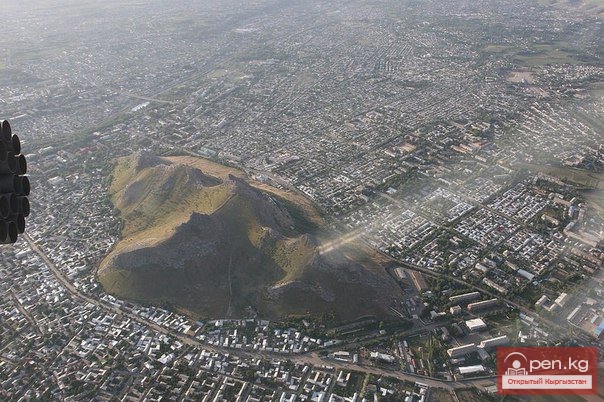Osh — the regional center of the republic, the oldest city in Kyrgyzstan.
Through publications of archaeological excavations and written sources, readers will become acquainted with the ancient settlements in the territory of Osh and the medieval city, witnessing the turbulent events of the restless feudal era, the participation of the townspeople in repelling invasions by conquerors, and the uprisings of the Kyrgyz population against the khanate-feudal oppression during the dominance of the Kokand Khanate. Documentary materials reveal shifts in the socio-economic and cultural development of the city after Kyrgyzstan's voluntary entry into Russia, as well as showcasing the actions of the working people of Osh during the two early revolutions in the country.
Osh — the regional center of the republic, the oldest city in Kyrgyzstan. In one interview, the famous Leningrad archaeologist, Doctor of Historical Sciences Yu. A. Zadneprovsky, who has been excavating the ancient layers of the city for a quarter of a century, referred to it as a contemporary of Troy. Indeed, the oldest layers of the city date back to ancient times. In the first millennium, one of the branches of the famous Silk Road, which connected the East with the West, passed through Osh; in the early Middle Ages, it was considered the third largest city in Fergana. Osh was at the center of southern Kyrgyz nomadism and served as a trading and transit point on the route from Central Asia to China and India.
It was one of the centers of the revolutionary movement of the working people for the establishment of Soviet power in Kyrgyzstan, serving as a stronghold in the fight against banditry in the Pamiro-Alai during the Civil War.
The history of the city is rich with significant events that are an integral part of the overall history of Kyrgyzstan, inseparable from the history of the formation and development of the Kyrgyz people. By turning to the history of the city, its stages of development, and comparing the past with the present, we see that the centuries-old aspirations of the Kyrgyz people, their struggle for freedom and a better life, became a reality only during the years of Soviet power. From a center of feudal and foreign oppression, the city transformed into a hub of socio-economic and cultural progress, becoming one of the outposts of socialist construction in Soviet Central Asia.
There are no special works on the pre-revolutionary history of Osh, and the brochures of a regional nature about the city's centuries-old past are written quite briefly. We have undertaken this modest and first attempt to recreate, in essay form, the pages of the history of ancient, medieval, and modern Osh (up to 1917) in the hope that it will aid in understanding the historical past of the southern regions of Kyrgyzstan, as well as draw attention to the issues of preserving and promoting the historical and cultural, including archaeological, monuments of Osh. Within the city limits, near its former public center, a historical and cultural reserve is being created in the open air, where archaeological work is becoming increasingly intense each year.
Today, for example, the idea of transforming Mount Suleiman into a reserve with many unique archaeological and architectural monuments is already being realized. Before the revolution, it was almost leased to Islamic preachers, who turned it into a center of ignorance, religious fanaticism, and cruel deception of the impoverished people. Now, a center for active atheistic propaganda and the dissemination of historical knowledge is being established here.
In addition to the recently discovered Bronze Age settlement, visitors to the museum-reserve will encounter rock paintings from ancient and medieval times, the mausoleum of Asaf ibn Burhiya — an architectural monument of the 11th century, and the mosque of Ravat Abdullah Khan from the 17th century. One will be able to familiarize themselves with the heritage and monuments of the ancestors of the Kyrgyz people from the Bronze Age to the late Middle Ages. And all this is alongside the manifestations of the vibrant life of the modern regional center of Soviet Kyrgyzstan — an ancient city in a new youthful guise. The Osh museum-reserve will feature a park ethnographic zone and a dendrological park. A cave museum complex is already operational, and nearby stands a monument commemorating the 50th anniversary of the Kyrgyz SSR.
Here, the ideas of V. I. Lenin about the preservation of antiquities as monuments of art, everyday life, and the life of the people in the past, about the organization of museums and conducting excursions based on them, are being realized.
At the present stage, new tasks for the further development of the spiritual culture of the Soviet people are being put forward. The enrichment and spiritual elevation of a person is impossible without knowledge of our history and culture, of what many generations of the multinational Soviet people lived by and were proud of.
The preservation of historical monuments in these conditions is not an end in itself. It is one of the effective means of ideologically and morally educating the working people in the spirit of mutual respect and friendship among all nations and ethnicities of the country, love for the Soviet Motherland, internationalism, and solidarity with the working people of other countries. This important task, which is to be addressed by Soviet and party bodies as well as public organizations, will also be met by the new museum-reserve being created. Our glorious past should serve the present, helping the practice of real socialism and the construction of the future.












































